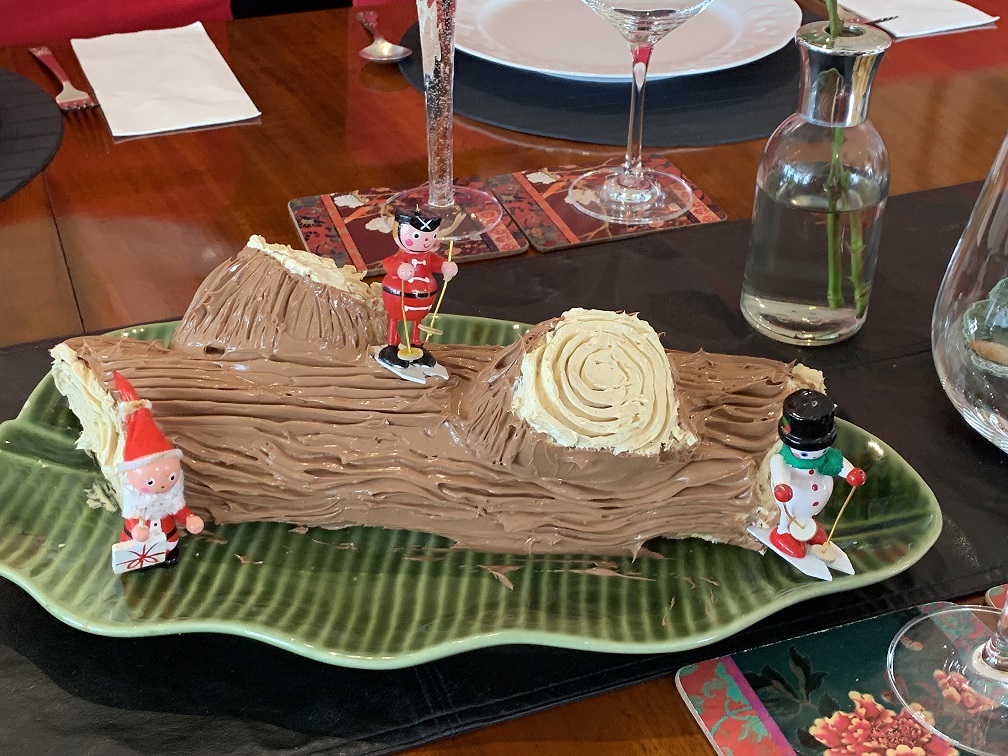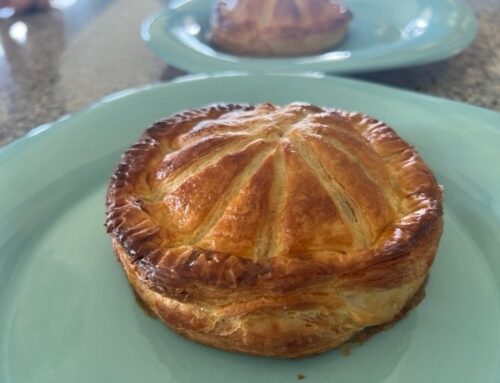At Christmas time, in our French Odyssey – Journey through France and the French Bistro Classics Desserts cooking classes we make this beautiful and delicious Bûche de Noël – French Yule Log ‘Christmas cake’. During the last class, I was asked about the French traditions behind this cake and so after a little research and discovery, I thought I would share with you what I found out about this lovely French tradition.
The Bûche de Noël is an elaborate cake consisting of a rolled, filled Génoise sponge cake, covered with chocolate buttercream to make it look like tree bark and the inside is a coffee or vanilla buttercream. In France, their bûche is often garnished and surrounded by meringue mushrooms, marzipan holly sprigs, spun sugar cobwebs and any other sort of edible decoration.
Apparently, the traditions of the bûche, stretch back to Europe’s Iron Age, before the medieval era. Back then, Celtic Brits and Gaelic Europeans would gather to welcome the winter solstice in December. People would feast to celebrate the days finally becoming longer, signalling the end of the winter season. To cleanse the air of the previous year’s events and to usher in the spring, families would burn huge logs decorated with holly, pinecones, or ivy. Wine and salt were also often used to annoint the logs. Once burned, the log’s ashes were valuable treasures said to have medicinal benefits and to guard against evil. Some groups claimed the ashes would protect the bearer from lightning, an important quality at a time when houses, and most of the contents in them, were made of wood.
The Yule log tradition continued after the introduction of Christianity, and there are many variations on exactly what are those traditions became to be. One story is that the ‘Lord of the Manor’, or whoever could afford it, and had enough space, cut a huge log of wood, put it into the fireplace, and burned it from Christmas until the twelfth day after Christmas. It must have been a HUGE log!
Later, it is said that families may have burned a log on Christmas Eve, but smaller hearths became the norm so huge logs were impractical. Those small hearths, however, were perfect for baking cakes.
It is not known who exactly made the first Yule log cake, but judging by the individual ingredients it is said to have been as early as the 1600s. Marzipan and meringue decorations, two of the most popular choices for Yule logs, appeared on many a medieval table. Sponge cake, which often constitutes the base of the log, is one of the oldest cakes still made today. It dates back to at least 1615, when the first known recipe appeared in Gervaise Markham’s book ‘The English Housewife.’
Another story tells that the first Christmas yule log, or Bûche de Noël, recipe was created in the late 1800s by a French pastry chef looking to replace and pay culinary homage to the original yule log tradition. As this new, gastronomic tradition became popular, the Christmas yule log, or Bûche de Noël, became famous worldwide.
Parisian bakers popularised the cake in the 19th century, and different bakeries became known for their more elaborate decorations. Sadly, it appears that nowadays, few people make Yule logs at home; they buy them from the patisserie.
I am pleased to say, that here in Australia, and me in St Kilda, always make the Christmas yule log, or Bûche de Noël, at Christmastime. So at Cooking in the Bay, we continue to play our part in maintaining this lovely tradition.







